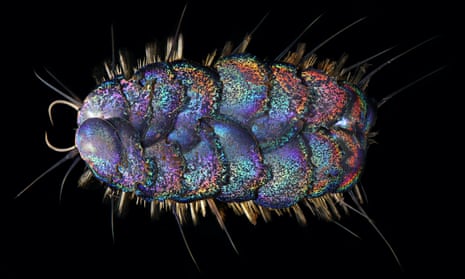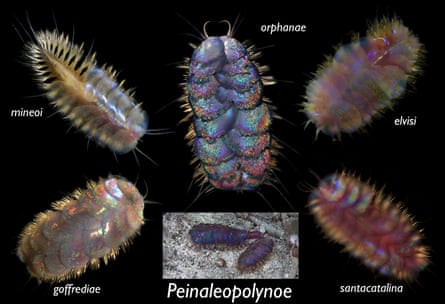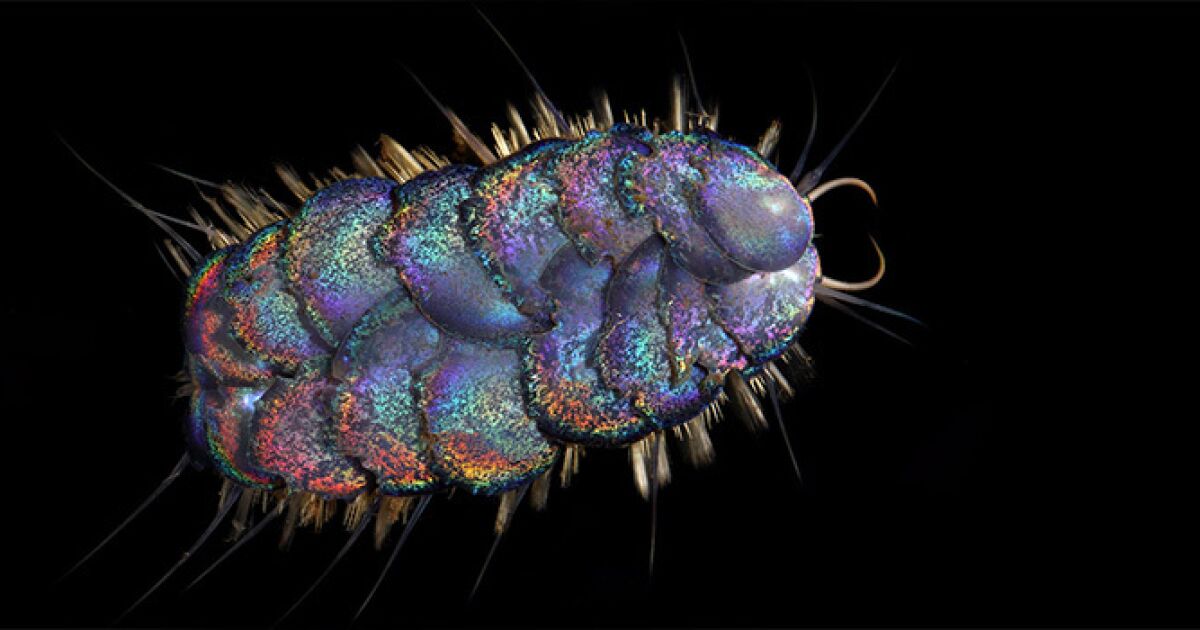In 2020, scientists found sparkling Peinaleopolynoe on hydothermal vents in the eastern Pacific – and were irresistibly reminded of the king of rock’n’roll
Nearly 4,000 metres (13,000 feet) underwater in the Pescadero basin in the Gulf of California lie some of the Pacific’s deepest hydrothermal vents – and they’re covered in small iridescent worms. “You’ll see little pink sparkly worms, blue ones, red ones, black ones and white ones,” says Avery Hiley, a graduate researcher at the Scripps Institution of Oceanography in San Diego.

These are hungry scale-worms, or Peinaleopolynoe – peinaléos meaning “hungry” or “famished” in Greek – named as such because they were first found clustered around a pile of food that scientists had left experimentally on the deep-sea floor. For years they have been nicknamed “Elvis worms” for their sparkling scales, reminiscent of the sequined jumpsuits worn by Elvis Presley.
There are six known species of hungry scale-worms, all roughly thumb-sized and living in the deep sea, including four named in 2020. One of these, which boasts a coat of shimmering pink scales, is specifically named after the king of rock’n’roll – Hiley and her colleagues named it Peinaleopolynoe elvisi.
Hungry scale-worms have been found on the carcasses of dead whales, and on volcanic seamounts, hydrothermal vents, and cold seeps, where methane trickles up through the seabed like champagne bubbles.

It is likely the worms are feeding on chemical-harnessing bacteria that grow on all these habitats. “They have jaws which we suspect they use to graze bacteria,” says Hiley. “So, we do think they’re bacteriovores.”
When Hiley and colleagues carried out genetic tests of the hungry scale-worms from the Pescadero basin, what they assumed were multiple species, each with its own colour, turned out to be a single species. “We realised that with age it seems that [the] species changes in colour, as it develops from a juvenile to an adult form.”
The worms’ colours are created not by pigments but by light reflecting and refracting within the internal structure of the scales, in the same way as with shining blue butterfly wings. The only light available in the deep sea to make them sparkle is the bioluminescence of other animals, but they gleam brilliantly in the headlights of deep-diving robots and submersibles.

It’s possible that as worms get older their colour changes because their scales grow thicker, altering how light passes through them. The thickest scales are blue. Slightly thinner are pink. “The littlest worms tend to always be white and the scales are very flimsy,” says Hiley.
Previously, when scientists collected specimens of hungry scale-worms, many had chips in their thick scales; they assumed their scales were damaged while being picked up by a deep-diving robot and transferred to the surface. Then, in 2017 at the Pescadero basin, a rare scene was caught on camera. “It turns out, actually, this species does this fighting ritual,” says Hiley.
Hungry scale-worms bounce on the spot and throw punches at each other, inverting their snout and biting chunks out of each other with their powerful jaws. “It was a piece of the puzzle that we didn’t know for a long time,” says Hiley.
It is still not clear why the worms fight each other. “We have more observation to do, definitely,” she says.
One more puzzle that Hiley wants to solve is how hungry scale-worms evolved from ancestors living in shallow seas to be able to survive in the low-oxygen, hyper-pressurised environment of the deep sea. She is looking for clues in their genes.
“We are starting to see some weird things on a genetic level with these deep-sea worms,” says Hiley. The 29 species of deep-sea scale-worms, including the hungry species, have a huge variation in their gene order compared with species of worms that live in shallow seas. Hiley is investigating whether this may somehow help explain how the worms have adapted to the rigours of the deep ocean.
Source: theguardian.com







